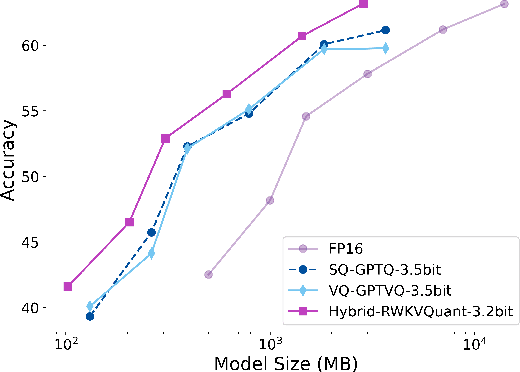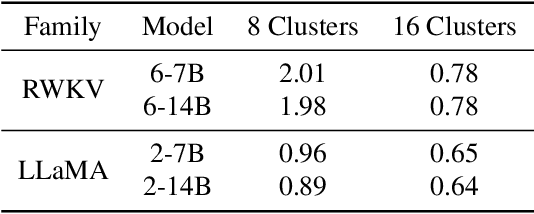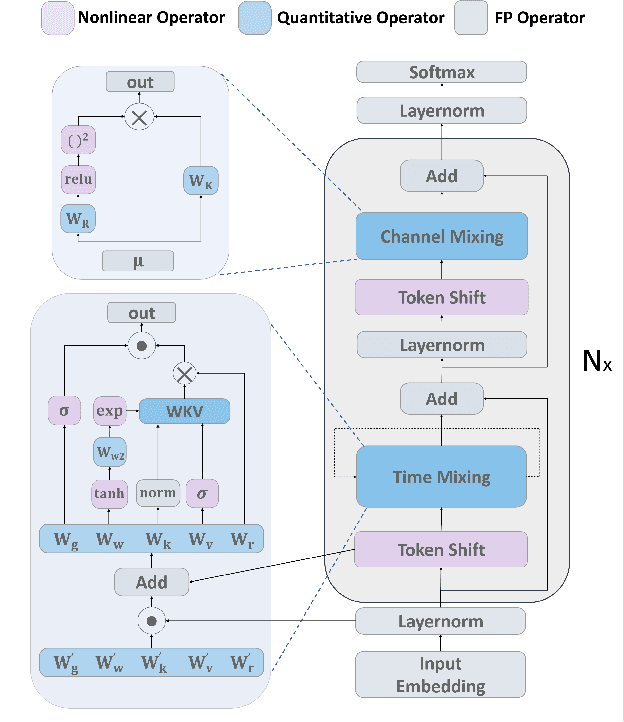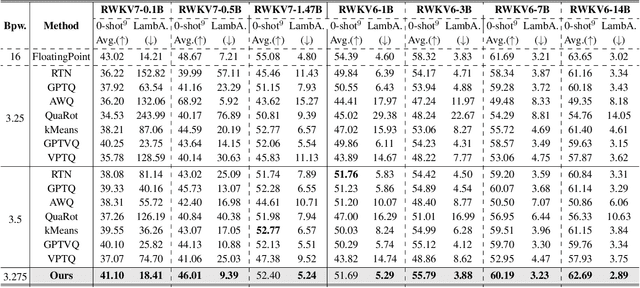Sifan Zhou
RWKVQuant: Quantizing the RWKV Family with Proxy Guided Hybrid of Scalar and Vector Quantization
May 02, 2025



Abstract:RWKV is a modern RNN architecture with comparable performance to Transformer, but still faces challenges when deployed to resource-constrained devices. Post Training Quantization (PTQ), which is a an essential technique to reduce model size and inference latency, has been widely used in Transformer models. However, it suffers significant degradation of performance when applied to RWKV. This paper investigates and identifies two key constraints inherent in the properties of RWKV: (1) Non-linear operators hinder the parameter-fusion of both smooth- and rotation-based quantization, introducing extra computation overhead. (2) The larger amount of uniformly distributed weights poses challenges for cluster-based quantization, leading to reduced accuracy. To this end, we propose RWKVQuant, a PTQ framework tailored for RWKV models, consisting of two novel techniques: (1) a coarse-to-fine proxy capable of adaptively selecting different quantization approaches by assessing the uniformity and identifying outliers in the weights, and (2) a codebook optimization algorithm that enhances the performance of cluster-based quantization methods for element-wise multiplication in RWKV. Experiments show that RWKVQuant can quantize RWKV-6-14B into about 3-bit with less than 1% accuracy loss and 2.14x speed up.
MoEQuant: Enhancing Quantization for Mixture-of-Experts Large Language Models via Expert-Balanced Sampling and Affinity Guidance
May 02, 2025



Abstract:Mixture-of-Experts (MoE) large language models (LLMs), which leverage dynamic routing and sparse activation to enhance efficiency and scalability, have achieved higher performance while reducing computational costs. However, these models face significant memory overheads, limiting their practical deployment and broader adoption. Post-training quantization (PTQ), a widely used method for compressing LLMs, encounters severe accuracy degradation and diminished generalization performance when applied to MoE models. This paper investigates the impact of MoE's sparse and dynamic characteristics on quantization and identifies two primary challenges: (1) Inter-expert imbalance, referring to the uneven distribution of samples across experts, which leads to insufficient and biased calibration for less frequently utilized experts; (2) Intra-expert imbalance, arising from MoE's unique aggregation mechanism, which leads to varying degrees of correlation between different samples and their assigned experts. To address these challenges, we propose MoEQuant, a novel quantization framework tailored for MoE LLMs. MoE-Quant includes two novel techniques: 1) Expert-Balanced Self-Sampling (EBSS) is an efficient sampling method that efficiently constructs a calibration set with balanced expert distributions by leveraging the cumulative probabilities of tokens and expert balance metrics as guiding factors. 2) Affinity-Guided Quantization (AGQ), which incorporates affinities between experts and samples into the quantization process, thereby accurately assessing the impact of individual samples on different experts within the MoE layer. Experiments demonstrate that MoEQuant achieves substantial performance gains (more than 10 points accuracy gain in the HumanEval for DeepSeekMoE-16B under 4-bit quantization) and boosts efficiency.
GSQ-Tuning: Group-Shared Exponents Integer in Fully Quantized Training for LLMs On-Device Fine-tuning
Feb 18, 2025Abstract:Large Language Models (LLMs) fine-tuning technologies have achieved remarkable results. However, traditional LLM fine-tuning approaches face significant challenges: they require large Floating Point (FP) computation, raising privacy concerns when handling sensitive data, and are impractical for resource-constrained edge devices. While Parameter-Efficient Fine-Tuning (PEFT) techniques reduce trainable parameters, their reliance on floating-point arithmetic creates fundamental incompatibilities with edge hardware. In this work, we introduce a novel framework for on-device LLM fine-tuning that eliminates the need for floating-point operations in both inference and training, named GSQ-Tuning. At its core is the Group-Shared Exponents Integer format, which efficiently represents model parameters in integer format using shared exponents among parameter groups. When combined with LoRA-like adapters, this enables fully integer-based fine-tuning that is both memory and compute efficient. We demonstrate that our approach achieves accuracy comparable to FP16-based fine-tuning while significantly reducing memory usage (50%). Moreover, compared to FP8, our method can reduce 5x power consumption and 11x chip area with same performance, making large-scale model adaptation feasible on edge devices.
GSRender: Deduplicated Occupancy Prediction via Weakly Supervised 3D Gaussian Splatting
Dec 19, 2024



Abstract:3D occupancy perception is gaining increasing attention due to its capability to offer detailed and precise environment representations. Previous weakly-supervised NeRF methods balance efficiency and accuracy, with mIoU varying by 5-10 points due to sampling count along camera rays. Recently, real-time Gaussian splatting has gained widespread popularity in 3D reconstruction, and the occupancy prediction task can also be viewed as a reconstruction task. Consequently, we propose GSRender, which naturally employs 3D Gaussian Splatting for occupancy prediction, simplifying the sampling process. In addition, the limitations of 2D supervision result in duplicate predictions along the same camera ray. We implemented the Ray Compensation (RC) module, which mitigates this issue by compensating for features from adjacent frames. Finally, we redesigned the loss to eliminate the impact of dynamic objects from adjacent frames. Extensive experiments demonstrate that our approach achieves SOTA (state-of-the-art) results in RayIoU (+6.0), while narrowing the gap with 3D supervision methods. Our code will be released soon.
MVCTrack: Boosting 3D Point Cloud Tracking via Multimodal-Guided Virtual Cues
Dec 03, 2024



Abstract:3D single object tracking is essential in autonomous driving and robotics. Existing methods often struggle with sparse and incomplete point cloud scenarios. To address these limitations, we propose a Multimodal-guided Virtual Cues Projection (MVCP) scheme that generates virtual cues to enrich sparse point clouds. Additionally, we introduce an enhanced tracker MVCTrack based on the generated virtual cues. Specifically, the MVCP scheme seamlessly integrates RGB sensors into LiDAR-based systems, leveraging a set of 2D detections to create dense 3D virtual cues that significantly improve the sparsity of point clouds. These virtual cues can naturally integrate with existing LiDAR-based 3D trackers, yielding substantial performance gains. Extensive experiments demonstrate that our method achieves competitive performance on the NuScenes dataset.
PTQ4RIS: Post-Training Quantization for Referring Image Segmentation
Sep 25, 2024Abstract:Referring Image Segmentation (RIS), aims to segment the object referred by a given sentence in an image by understanding both visual and linguistic information. However, existing RIS methods tend to explore top-performance models, disregarding considerations for practical applications on resources-limited edge devices. This oversight poses a significant challenge for on-device RIS inference. To this end, we propose an effective and efficient post-training quantization framework termed PTQ4RIS. Specifically, we first conduct an in-depth analysis of the root causes of performance degradation in RIS model quantization and propose dual-region quantization (DRQ) and reorder-based outlier-retained quantization (RORQ) to address the quantization difficulties in visual and text encoders. Extensive experiments on three benchmarks with different bits settings (from 8 to 4 bits) demonstrates its superior performance. Importantly, we are the first PTQ method specifically designed for the RIS task, highlighting the feasibility of PTQ in RIS applications. Code will be available at {https://github.com/gugu511yy/PTQ4RIS}.
P2P: Part-to-Part Motion Cues Guide a Strong Tracking Framework for LiDAR Point Clouds
Jul 09, 2024Abstract:3D single object tracking (SOT) methods based on appearance matching has long suffered from insufficient appearance information incurred by incomplete, textureless and semantically deficient LiDAR point clouds. While motion paradigm exploits motion cues instead of appearance matching for tracking, it incurs complex multi-stage processing and segmentation module. In this paper, we first provide in-depth explorations on motion paradigm, which proves that (\textbf{i}) it is feasible to directly infer target relative motion from point clouds across consecutive frames; (\textbf{ii}) fine-grained information comparison between consecutive point clouds facilitates target motion modeling. We thereby propose to perform part-to-part motion modeling for consecutive point clouds and introduce a novel tracking framework, termed \textbf{P2P}. The novel framework fuses each corresponding part information between consecutive point clouds, effectively exploring detailed information changes and thus modeling accurate target-related motion cues. Following this framework, we present P2P-point and P2P-voxel models, incorporating implicit and explicit part-to-part motion modeling by point- and voxel-based representation, respectively. Without bells and whistles, P2P-voxel sets a new state-of-the-art performance ($\sim$\textbf{89\%}, \textbf{72\%} and \textbf{63\%} precision on KITTI, NuScenes and Waymo Open Dataset, respectively). Moreover, under the same point-based representation, P2P-point outperforms the previous motion tracker M$^2$Track by \textbf{3.3\%} and \textbf{6.7\%} on the KITTI and NuScenes, while running at a considerably high speed of \textbf{107 Fps} on a single RTX3090 GPU. The source code and pre-trained models are available at \url{https://github.com/haooozi/P2P}.
Sub-SA: Strengthen In-context Learning via Submodular Selective Annotation
Jul 08, 2024



Abstract:In-context learning (ICL) leverages in-context examples as prompts for the predictions of Large Language Models (LLMs). These prompts play a crucial role in achieving strong performance. However, the selection of suitable prompts from a large pool of labeled examples often entails significant annotation costs. To address this challenge, we propose \textbf{Sub-SA} (\textbf{Sub}modular \textbf{S}elective \textbf{A}nnotation), a submodule-based selective annotation method. The aim of Sub-SA is to reduce annotation costs while improving the quality of in-context examples and minimizing the time consumption of the selection process. In Sub-SA, we design a submodular function that facilitates effective subset selection for annotation and demonstrates the characteristics of monotonically and submodularity from the theoretical perspective. Specifically, we propose \textbf{RPR} (\textbf{R}eward and \textbf{P}enalty \textbf{R}egularization) to better balance the diversity and representativeness of the unlabeled dataset attributed to a reward term and a penalty term, respectively. Consequently, the selection for annotations can be effectively addressed with a simple yet effective greedy search algorithm based on the submodular function. Finally, we apply the similarity prompt retrieval to get the examples for ICL.
TimeLDM: Latent Diffusion Model for Unconditional Time Series Generation
Jul 05, 2024



Abstract:Time series generation is a crucial research topic in the area of deep learning, which can be used for data augmentation, imputing missing values, and forecasting. Currently, latent diffusion models are ascending to the forefront of generative modeling for many important data representations. Being the most pivotal in the computer vision domain, latent diffusion models have also recently attracted interest in other communities, including NLP, Speech, and Geometric Space. In this work, we propose TimeLDM, a novel latent diffusion model for high-quality time series generation. TimeLDM is composed of a variational autoencoder that encodes time series into an informative and smoothed latent content and a latent diffusion model operating in the latent space to generate latent information. We evaluate the ability of our method to generate synthetic time series with simulated and realistic datasets, benchmark the performance against existing state-of-the-art methods. Qualitatively and quantitatively, we find that the proposed TimeLDM persistently delivers high-quality generated time series. Sores from Context-FID and Discriminative indicate that TimeLDM consistently and significantly outperforms current state-of-the-art benchmarks with an average improvement of 3.4$\times$ and 3.8$\times$, respectively. Further studies demonstrate that our method presents better performance on different lengths of time series data generation. To the best of our knowledge, this is the first study to explore the potential of the latent diffusion model for unconditional time series generation and establish a new baseline for synthetic time series.
PillarHist: A Quantization-aware Pillar Feature Encoder based on Height-aware Histogram
May 29, 2024



Abstract:Real-time and high-performance 3D object detection plays a critical role in autonomous driving and robotics. Recent pillar-based 3D object detectors have gained significant attention due to their compact representation and low computational overhead, making them suitable for onboard deployment and quantization. However, existing pillar-based detectors still suffer from information loss along height dimension and large numerical distribution difference during pillar feature encoding (PFE), which severely limits their performance and quantization potential. To address above issue, we first unveil the importance of different input information during PFE and identify the height dimension as a key factor in enhancing 3D detection performance. Motivated by this observation, we propose a height-aware pillar feature encoder named PillarHist. Specifically, PillarHist statistics the discrete distribution of points at different heights within one pillar. This simple yet effective design greatly preserves the information along the height dimension while significantly reducing the computation overhead of the PFE. Meanwhile, PillarHist also constrains the arithmetic distribution of PFE input to a stable range, making it quantization-friendly. Notably, PillarHist operates exclusively within the PFE stage to enhance performance, enabling seamless integration into existing pillar-based methods without introducing complex operations. Extensive experiments show the effectiveness of PillarHist in terms of both efficiency and performance.
 Add to Chrome
Add to Chrome Add to Firefox
Add to Firefox Add to Edge
Add to Edge